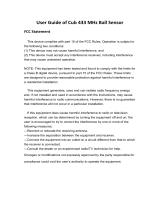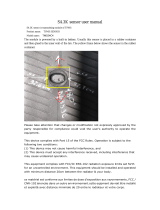
Installation Instruction for Uni Sensor Evo
Model : TPM103 Series : B121-040 / B121-042
After you have programmed the Uni-sensor Evo, following installation procedures below.
Important:
Each time the TPMS sensor is changed or disassembled, it is MANDATORY to replace the TPMS valve and screw (use only Cub TPMS valves
designed for TPMS sensor) to ensure proper sealing.
1.Clamp-In Valve Sensors:
1.1 If the valve is already assembled with the sensor, please directly skip to 1.2. Place the valve body on the sensor, tighten the screw with
1.35 -1.4 Nm by T20 torx screw driver.
1.2 Loose the valve cap and valve stem nut from the valve stem.
1.3 Insert assembled sensor & valve stem into wheel. Hold in place by hand.
1.4 From outside wheel, put on valve stem nut. With torque wrench, tighten valve stem nut to 4.0Nm.
1.5 Prohibited use for racing.
2.Snap-In Valve Sensors:
Avoid wet and extreme temperatures. Never install a used screw or used snap-in valve.
2.1 If the valve is already assembled with the sensor, please directly skip to 2.2. Place the valve body on the sensor, tighten the screw with
1.35 -1.4 Nm by T20 torx screw driver.
2.2 Apply tire soap or lube solution to rubber valve stem.
2.3 Line sensor up with rim hole and attach a standard tire snap-in valve puller tool to the end of the valve.
2.4 Pull the valve stem straight through the valve hole. Refer to your TTV tool manual for proper installation. Force to seat shall not exceed
40kg(90lb).
2.5 Prohibited use for racing and beyond 210 km/h.
It is recommended to seek the service of a qualified technician. Pay special attention and follow all instructions to all cautions and warnings
included in the vehicle user manual. Failure to do so could result in failure of the vehicle’s Tire Pressure Monitoring System(TPMS) sensors to
function properly, or result in damage to the TPMS sensor. If the System continues to fail, please contact with local distributor or authorized
dealer. Our sensor assemblies are designed and manufactured to be operated in Original Equipment wheels. While using non-OE wheels, the
vehicle owner has responsibility to ensure that the TPMS is working correctly. Cub does not assume any liability in case of faulty, incorrect
installation of the product, or by using other product causing TPMS sensor malfunction on the part of customer or user.
FCC Statement: FCC ID: ZPNTPM103
This device complies with part 15 of the FCC Rules. Operation is subject to the following two conditions:
(1) This device may not cause harmful interference, and
(2) this device must accept any interference received, including interference that may cause undesired operation.
NOTE: This equipment has been tested and found to comply with the limits for a Class B digital device, pursuant to part 15 of the FCC Rules. These limits are designed to provide
reasonable protection against harmful interference in a residential installation.
This equipment generates, uses and can radiate radio frequency energy and, if not installed and used in accordance with the instructions, may cause harmful interference to radio
communications. However, there is no guarantee that interference will not occur in a particular installation.
If this equipment does cause harmful interference to radio or television reception, which can be determined by turning the equipment off and on, the user is encouraged to try to
correct the interference by one or more of the following measures:
—Reorient or relocate the receiving antenna.
—Increase the separation between the equipment and receiver.
—Connect the equipment into an outlet on a circuit different from that to which the receiver is connected.
—Consult the dealer or an experienced radio/TV technician for help.
Changes or modifications not expressly approved by the party responsible for compliance could void the user’s authority to operate the equipment.
This equipment complies with FCC radiation exposure limits set forth for an uncontrolled environment. This equipment should be installed and operated with a minimum distance of 20
cm between the radiator and a human body.
ISED Statement: HVIN: TPM103 IC ID:9959A-TPM103
For Canada, the “compliance statement and unlicensed device usage conditions” which must be shown in the user manual has changed.
It should now read like this:
This device contains licence-exempt transmitter(s) that comply with Innovation, Science and Economic Development Canada’s licence-exempt RSS(s). Operation is subject to the
following two conditions:
(1) this device may not cause interference,
(2) this device must accept any interference, including interference that may cause undesired operation of the device.
L’émetteur exempt de licence contenu dans le présent appareil est conforme aux CNR d’Innovation, Sciences et Développement économique Canada applicables aux appareils radio
exempts de licence. L’exploitation est autorisée aux deux conditions suivantes :
1) L’appareil ne doit pas produire de brouillage;
2) L’appareil doit accepter tout brouillage radioélectrique subi, même si le brouillage est susceptible d’en compromettre le fonctionnement.
This equipment complies with ISED radiation exposure limits set forth for an uncontrolled environment. This equipment should be installed and operated with a minimum distance of 20
cm between the radiator and a human body.
Cet équipement est conforme aux limites d'exposition aux rayonnements ISED établies pour un environnement non contrôlé. Cet équipement doit être installé et utilisé avec une distan
ce minimale de 20 cm entre le radiateur et un corps humain.
CUB ELECPARTS INC.
NO. 6, LANE 546, SEC. 6, CHANGLU RD., FUHSIN TOWNSHIP, CHANGHUA COUNTY 50648, TAIWAN
HTTP://WWW.CUBELEC.COM
To obtain repair or replacement of the product under warranty, or general inquires, assistance, please contact our local distributor.
TELEX
-
 1
1
dans d''autres langues
- English: CUB ELECPARTS TPM103 User manual
Autres documents
-
iAuditor UMWLBW Mode d'emploi
-
 Cub TPM101 Mode d'emploi
Cub TPM101 Mode d'emploi
-
TPMS Sensor Guide d'installation
-
Continental TIS-21 Mode d'emploi
-
Mazda mx-5 2016 Manuel utilisateur
-
 BH SENS S4.3K TPMS Sensor Manuel utilisateur
BH SENS S4.3K TPMS Sensor Manuel utilisateur
-
KTM 63512931144 Le manuel du propriétaire
-
Sigma EOX VIEW 1200 Operating And Mounting Instructions Manual
-
Matco Tools DT4B Operating Instructions Manual
-
AL-KO 2LINK Installation Instructions Manual


